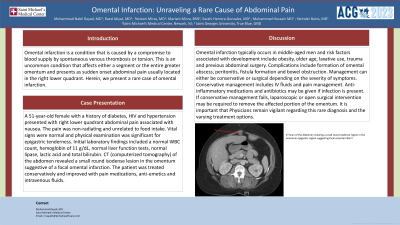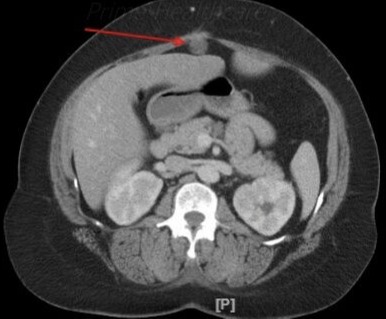Sunday Poster Session
Category: Small Intestine
P1264 - Omental Infarction: Unraveling a Rare Cause of Abdominal Pain
Sunday, October 22, 2023
3:30 PM - 7:00 PM PT
Location: Exhibit Hall

Has Audio

Raed Atiyat, MD
Saint Michael's Medical Center
Newark, New Jersey
Presenting Author(s)
Mohammad Nabil Rayad, MD1, Raed Atiyat, MD2, Noreen Mirza, MD1, Mariam Mirza, BSN1, Sarahi Herrera-Gonzalez, MD1, Muhammad Hussain, MD2, Yatinder Bains, MD1
1Saint Michael's Medical Center, New York Medical College, Newark, NJ; 2Saint Michael's Medical Center, Newark, NJ
Introduction: Omental infarction is a condition that is caused by a compromise to blood supply by spontaneous venous thrombosis or torsion. This is an uncommon condition that affects either a segment or the entire greater omentum and presents as sudden onset abdominal pain usually located in the right lower quadrant. Herein, we present a rare case of omental infarction.
Case Description/Methods: A 51-year-old female with a history of diabetes, HIV and hypertension presented with right lower quadrant abdominal pain associated with nausea. The pain was non-radiating and unrelated to food intake. Vital signs were normal and physical examination was significant for epigastric tenderness. Initial laboratory findings included a normal WBC count, hemoglobin of 11 g/dL, normal liver function tests, normal lipase, lactic acid and total bilirubin. CT (computerized tomography) of the abdomen revealed a small round isodense lesion in the omentum suggestive of a focal omental infarction. The patient was treated conservatively and improved with pain medications, anti-emetics and intravenous fluids.
Discussion: Omental infarction typically occurs in middle-aged men and risk factors associated with development include obesity, older age, laxative use, trauma and previous abdominal surgery. Complications include formation of omental abscess, peritonitis, fistula formation and bowel obstruction. Management can either be conservative or surgical depending on the severity of symptoms. Conservative management includes IV fluids and pain management. Anti-inflammatory medications and antibiotics may be given if infection is present. If conservative management fails, laparoscopic or open surgical intervention may be required to remove the affected portion of the omentum. It is important that Physicians remain vigilant regarding this rare diagnosis and the varying treatment options.

Disclosures:
Mohammad Nabil Rayad, MD1, Raed Atiyat, MD2, Noreen Mirza, MD1, Mariam Mirza, BSN1, Sarahi Herrera-Gonzalez, MD1, Muhammad Hussain, MD2, Yatinder Bains, MD1. P1264 - Omental Infarction: Unraveling a Rare Cause of Abdominal Pain, ACG 2023 Annual Scientific Meeting Abstracts. Vancouver, BC, Canada: American College of Gastroenterology.
1Saint Michael's Medical Center, New York Medical College, Newark, NJ; 2Saint Michael's Medical Center, Newark, NJ
Introduction: Omental infarction is a condition that is caused by a compromise to blood supply by spontaneous venous thrombosis or torsion. This is an uncommon condition that affects either a segment or the entire greater omentum and presents as sudden onset abdominal pain usually located in the right lower quadrant. Herein, we present a rare case of omental infarction.
Case Description/Methods: A 51-year-old female with a history of diabetes, HIV and hypertension presented with right lower quadrant abdominal pain associated with nausea. The pain was non-radiating and unrelated to food intake. Vital signs were normal and physical examination was significant for epigastric tenderness. Initial laboratory findings included a normal WBC count, hemoglobin of 11 g/dL, normal liver function tests, normal lipase, lactic acid and total bilirubin. CT (computerized tomography) of the abdomen revealed a small round isodense lesion in the omentum suggestive of a focal omental infarction. The patient was treated conservatively and improved with pain medications, anti-emetics and intravenous fluids.
Discussion: Omental infarction typically occurs in middle-aged men and risk factors associated with development include obesity, older age, laxative use, trauma and previous abdominal surgery. Complications include formation of omental abscess, peritonitis, fistula formation and bowel obstruction. Management can either be conservative or surgical depending on the severity of symptoms. Conservative management includes IV fluids and pain management. Anti-inflammatory medications and antibiotics may be given if infection is present. If conservative management fails, laparoscopic or open surgical intervention may be required to remove the affected portion of the omentum. It is important that Physicians remain vigilant regarding this rare diagnosis and the varying treatment options.

Figure: CT Scan of the Abdomen showing a small round isodense region in the omentum epigastric region suggesting focal omental infarct.
Disclosures:
Mohammad Nabil Rayad indicated no relevant financial relationships.
Raed Atiyat indicated no relevant financial relationships.
Noreen Mirza indicated no relevant financial relationships.
Mariam Mirza indicated no relevant financial relationships.
Sarahi Herrera-Gonzalez indicated no relevant financial relationships.
Muhammad Hussain indicated no relevant financial relationships.
Yatinder Bains indicated no relevant financial relationships.
Mohammad Nabil Rayad, MD1, Raed Atiyat, MD2, Noreen Mirza, MD1, Mariam Mirza, BSN1, Sarahi Herrera-Gonzalez, MD1, Muhammad Hussain, MD2, Yatinder Bains, MD1. P1264 - Omental Infarction: Unraveling a Rare Cause of Abdominal Pain, ACG 2023 Annual Scientific Meeting Abstracts. Vancouver, BC, Canada: American College of Gastroenterology.
